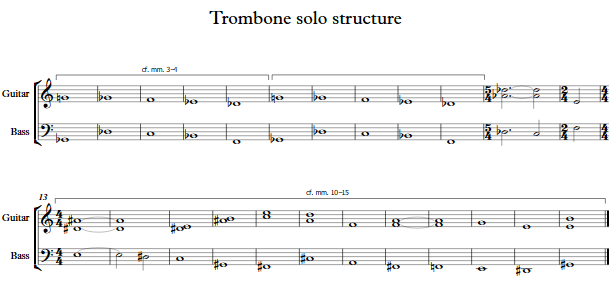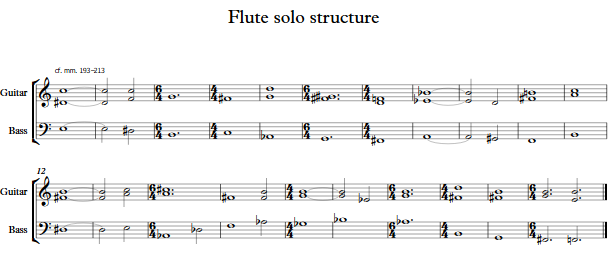I’ve had a little more time now to study the structure of this piece.
First, I’ll lay out the form as I see it:
- 0:00—0:13 (mm. 1—5): Intro figure
- 0:13—0:28 (mm. 6—9): Guitar & bass cycle 1
- 0:28—0:43 (mm. 10—15): Head
- 0:43—0:48 (mm. 16—17): Bridging material (based on m. 2)
- 0:48—3:31 (mm. 18—41, 42—65, 66—89): Trombone solo (based on mm. 3—4, 10—15)
- 3:31—5:13 (mm. 90—94, 95—99, 100—104, 105—109, 110—114, 115—119, 120—124, 125—129): Guitar solo (based on mm. 183—185)
- 5:13—7:04 (mm. 130—150, 151—171): Flute solo (based on mm. 193—213)
- 7:04—7:21 (mm. 172—176): Guitar & bass cycle 1
- 7:21—7:35 (mm. 177—182): Head
- 7:35—7:59 (mm. 183—191): Guitar & bass cycle 2
- 7:59—8:03 (m. 192): Coda intro measure
- 8:03—8:27 (mm. 193—213): Coda
- 8:27—8:35 (mm. 214—217): Ending tag
And here are what I could make of the harmonies of the solo sections. These were deduced by looking at both the actual comping performed during the solos and the source material that the solo structure comes from. There are some discrepancies, which is to be expected, although a few them turned out to be transcription errors, which is a good sign (for the model).



Interestingly, I didn’t notice any regular correspondence between parts for the flute and trombone.
Some future steps:
- Look for any rules governing the harmonic skeleton. For example, there often seem to be common intervals between one “chord” and the next.
- Look for rules governing the flute and trombone solos; they seem to be much freer than the guitar solo.
- See if I can find any way that the flute and trombone parts in the through-composed material (such as the head and coda) are reused or referred to. Currently only the guitar and bass parts seem to be structurally interesting.
- Try to discover the function, if any, of the sections that I haven’t linked to any other sections yet, for example the coda intro measure (m. 192) and ending tag (mm. 214—217).
Post a Comment